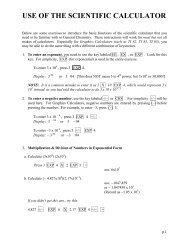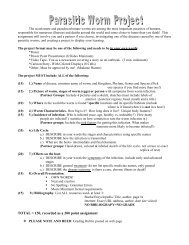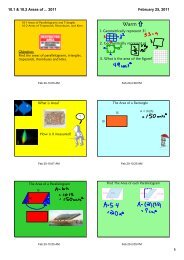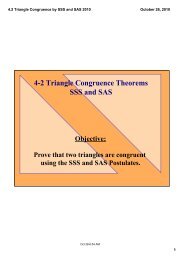Electron Filling Order PowerPoint
Electron Filling Order PowerPoint
Electron Filling Order PowerPoint
Create successful ePaper yourself
Turn your PDF publications into a flip-book with our unique Google optimized e-Paper software.
<strong>Electron</strong> <strong>Filling</strong> <strong>Order</strong>Quantum Numbers
Orbital <strong>Filling</strong> <strong>Order</strong>It would be nice if an atom’s orbitalssimply filled in the order we havealready seen.If that were the case, this would be verysimple (and we would be teaching it to4 th graders.)
Quantum NumberBy using 4 part quantum number, wecan uniquely describe every one of anatom’s electrons.Every electron has a unique energy,and inhabits a particular region ofspace (orbital) based on that energy.
Quantum NumbersEvery quantum number has 4 parts:n = Principal energy level (PEL)l = Sublevel (s, p, d, f)m l = Orbital (ex, p x , p y , p z )m s = Spin (↑ or ↓)
<strong>Filling</strong> <strong>Order</strong> RulesThere are 3 main rules that governelectron filling order for atoms:• The Pauli Principle• Hund’s Rule• The aufbau diagram
The Pauli PrincipleThe Pauli Principle states that a singleorbital, regardless of size or shape, maycontain no more than 2 electrons, andthose electrons must have oppositespin.It is thought that opposing spinsreduces the repulsion between theelectrons, which are both negativelycharged.
Hund’s RuleHund’s Rule states that when filling aset of equal energy orbitals (such as thep-orbitals of PEL 2) each orbital getsone electron before any orbital gets 2.<strong>Electron</strong>s would like to be as far fromeach other as possible. They need their“personal space.”We will discuss examples of this in amoment.
The Aufbau Diagram“Aufbau” is Germanfor “build” or “buildup.”It shows the order inwhich energysublevels fill withelectrons.Learn to draw thediagram frommemory.E7s 7p 7d 7f6s 6p 6d 6f5s 5p 5d 5f4s 4p 4d 4f3s 3p 3d2s 2p1s
Aufbau DiagramThe sublevels inyellow areunnecessarybecause there areno atoms withenough electrons tofill these levels.But, it doesn’t hurt todraw them in if it’seasier to remember.E7s 7p 7d 7f6s 6p 6d 6f5s 5p 5d 5f4s 4p 4d 4f3s 3p 3d2s 2p1s
Aufbau DiagramTo use the diagram,simply follow thearrows, and rememberthe maximum numberof electrons each typeof sublevel can hold:s 2 , p 6 , d 10 , and f 14E7s 7p 7d 7f6s 6p 6d 6f5s 5p 5d 5f4s 4p 4d 4f3s 3p 3d2s 2p1s
Representing <strong>Electron</strong>sThere are 3 types of electron diagrams:An electron configuration,An orbital filling diagram, andA Lewis or electron dot diagram.Here are examples of each.
Representing <strong>Electron</strong>sAn electron configuration diagramshows PEL, sublevel, and how manyelectrons are in each sublevel.3p 43 rd PEL p-sublevel 4e-
Representing <strong>Electron</strong>sAn orbital filling diagram uses a box orline to represent each atomic orbital.Under each box or line is the orbitaldesignation.Arrows are used to show 1 or 2electrons and their spin.↑↓2s
Representing <strong>Electron</strong>sA Lewis or electron dot diagram showsa series of 1-8 dots in pairs around theelement symbol.Only electrons in the highest numberedPEL are shown. These are calledvalence or outer shell electrons.Ne
ExamplesLet’s start with Hydrogen, the simplestelement and go on to more complexexamples showing all 3 types ofdiagrams.Let’s also practice the 3 filling orderrules we saw earlier.
A Short CutIt is OK to abbreviate electronconfigurations using a “noble gas core”to show the atom’s first severalelectrons, followed by any electrons thatatom has beyond the core.Let’s use Scandium as an example.
Noble Gas CoresEx. Ar: 1s 2 2s 2 2p 6 3s 2 3p 6Sc: 1s 2 2s 2 2p 6 3s 2 3p 6 4s 2 3d 1Note that Scandium’s first 18 electrons(up through 3p 6 ) are the same asArgon’s.So, we may abbreviate Sc’s structure as[Ar] 4s 2 3d 1 , using Ar as the noble gascore and adding the extra electrons thatSc has.
Noble Gas CoresTo chose the correct noble gas core,select the noble gas from column VIII(18) on the periodic table that is closest,but smaller than the element you wishto abbreviate.In other words, select the noble gasfrom the end of the row above yourelement.
Noble Gas CoresSo, how do you know where to startwith electrons after the noble gas?All the noble gases (except He) have p 6as the last electron added.For example, Kr is at the end of row 4,so its last electron was 4p 6 .We would begin the next element with5s.
Exceptions to the RulesThere are many exceptions to the fillingorder rules.Most are unpredictable, except these.The d-sublevel has 5 orbitals.There seems to be somethingenergetically stable about having thatsublevel exactly half full (d 5 ) orcompletely full (d 10 ).
Exceptions to the RulesExamples:Chromium is element 24 and copper is 29.Element Predicted e-configurationActual e-configurationCr [Ar] 4s 2 3d 4 [Ar] 4s 1 3d 5Cu [Ar] 4s 2 3d 9 [Ar] 4s 1 3d 10
Exceptions to the RulesWith most all of the d 4 and d 9 elements,an s- electron gets “borrowed” to makethe d-sublevel half full or completely full.These are the most predictableexceptions to the rules and the onesyou should know.Even these are not absolute. Tungsten(W) does not follow the rule.
Putting It All TogetherSo, how does all this orbital stuff fittogether?How is it that all these electrons canoccupy a seemingly common spacewithout running into each other?
Putting It All Together

















